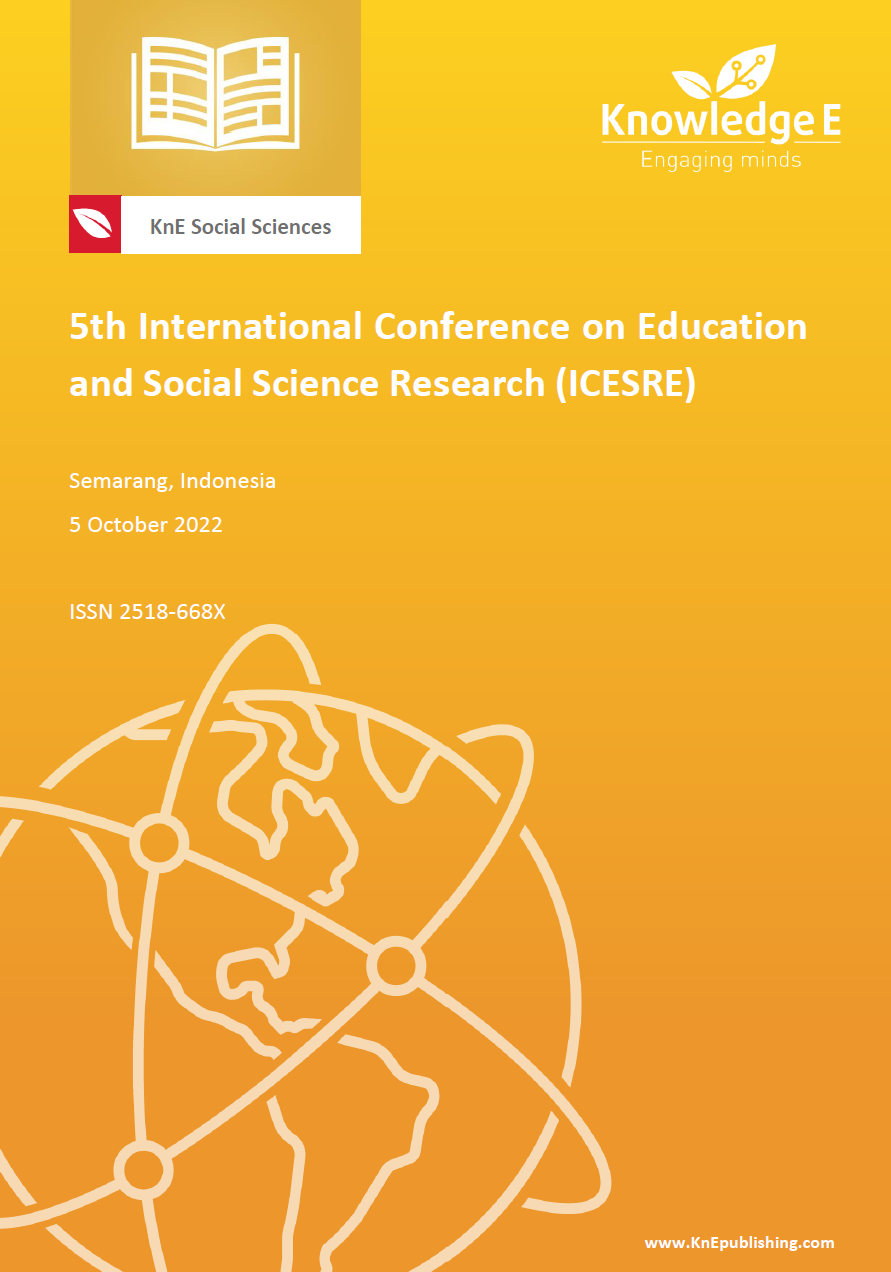Flashcard-Based Augmented Reality To Increase Students' Scientific Literacy
DOI:
https://doi.org/10.18502/kss.v7i19.12441Abstract
Augmented Reality (AR) is a type of learning media that combines virtual and real worlds in real-time. It can make it easier for students to visualize the phenomena. This research aimed to measure flashcard-based AR’s effectiveness based on scientific literature. This research used a quasi-experimental method using a post-test-only control group design, and the participants were 60 college students at Universitas PGRI Adi Buana Surabaya. Data in the research were collected through tests to determine students’ scientific literacy skills, including aspects of knowledge and competence in analyzing scientific phenomena, connecting physics concepts to existing phenomena, and interpreting data or scientific evidence and questionnaires. The data were analyzed by calculating the average test score according to scientific literature and the percentage of user satisfaction. Based on the research, using flashcard-based augmented reality could increase the students’ scientific literacy.
Keywords: augmented reality; learning media; scientific literacy
References
Rachmadtullah R, Yustitia V, Setiawan B, Fanny AM, Pramulia P, Susiloningsih W, et al. The challenge of elementary school teachers to encounter superior generation in the 4.0 industrial revolution: Study literature. International Journal of Scientific & Technology Research. 2020;9:1879–1882.
Bratianu C, Hadad S, Bejinaru R. Paradigm shift in business education: A competence-based approach. Sustainability. 2020;12.
Caena F, Redecker C. Aligning teacher competence frameworks to 21st century challenges: The case for the European Digital Competence Framework for Educators (Digcompedu). European Journal of Education. 2019;54:356–369.
Buchanan RA, Forster DJ, Douglas S, Nakar S, Boon HJ, Heath T, et al. Philosophy of education in a new key: Exploring new ways of teaching and doing ethics in education in the 21st century. Educational Philosophy and Theory. 2022;54:1178– 1197.
Adnan AHM, Rahmat AM, Mohtar NM, Anuar N. Industry 4.0 critical skills and career readiness of ASEAN TVET tertiary students in Malaysia, Indonesia and Brunei. Journal of Physics: Conference Series. 2021;1793:012004.
Valladares L. Scientific literacy and social transformation. Science & Education. 2021;30:557–587.
Suprapto N. What should educational reform in Indonesia look like? Learning from the PISA science scores of East-Asian countries and Singapore. Asia-Pacific Forum on Science Learning and Teaching. 2016;17.
Nugrahanto S, Zuchdi D. Indonesia PISA result and impact on the reading learning program in Indonesia. Netherlands: Atlantis Press; 2019. p. 373–377.
Rubini B, Ardianto D, Pursitasari I, Permana I. Identify scientific literacy from the science teachers’perspective. Jurnal Pendidikan IPA Indonesia. 2016;5:299–303.
Hamzah ML, Rizal F, Simatupang W. Development of augmented reality application for learning computer network device. International Journal of Interactive Mobile Technologies. 2021;15.
Cai S, Liu E, Shen Y, Liu C, Li S, Shen Y. Probability learning in mathematics using augmented reality: Impact on student’s learning gains and attitudes. Interactive Learning Environments. 2020;28:560–573.
Cheng Y-W, Wang Y, Cheng I-L, Chen N-S. An in-depth analysis of the interaction transitions in a collaborative Augmented Reality-based mathematic game. Interactive Learning Environments. 2019;27:782–796.
Fidan M, Tuncel M. Integrating augmented reality into problem-based learning: The effects on learning achievement and attitude in physics education. Computers & Education. 2019;142:103635.
Thees M, Kapp S, Strzys MP, Beil F, Lukowicz P, Kuhn J. Effects of augmented reality on learning and cognitive load in university physics laboratory courses. Computers in Human Behavior. 2020;108:106316.
Fan M, Antle AN, Warren JL. Augmented reality for early language learning: A systematic review of augmented reality application design, instructional strategies, and evaluation outcomes. Journal of Educational Computing Research. 2020;58:1059–1100.
Parmaxi A, Demetriou AA. Augmented reality in language learning: A state of the art review of 2014–2019. Journal of Computer Assisted Learning. 2020;36:861–875.
Toledo-Morales P, Sanchez-Garcia JM. Use of augmented reality in social sciences as educational resource. Turkish Online Journal of Distance Education. 2018;19:38–52.
Zheng W, Zhou Y, Qin Y. An empirical study of incorporation of augmented reality into civic education. ICMET 2019: Proceedings of the 2019 International Conference on Modern Educational Technology. 2019:30–34.
Faridi H, Tuli N, Mantri A, Singh G, Gargrish S. A framework utilizing augmented reality to improve critical thinking ability and learning gain of the students in Physics. Computer Applications in Engineering Education. 2021;29:258–273.
Syawaludin A, Rintayati P. Development of augmented reality-based interactive multimedia to improve critical thinking skills in science learning. International Journal of Instruction. 2019;12:331–344.
Chiang TH, Yang SJ, Hwang G-J. Students’ online interactive patterns in augmented reality-based inquiry activities. Computers & Education. 2014;78:97–108.
Lin C-Y, Chai H-C, Wang J, Chen C-J, Liu Y-H, Chen C-W, et al. Augmented reality in educational activities for children with disabilities. Displays. 2016;42:51–54.
Furió D, Juan M, Seguí I, Vivó R. Mobile learning vs. traditional classroom lessons: A comparative study. Journal of Computer Assisted Learning. 2015;31:189–201.
Han J, Jo M, Hyun E, So H-J. Examining young children’s perception toward augmented reality-infused dramatic play. Educational Technology Research and Development. 2015;63:455–474.
Techakosit S, Wannapiroon P. Connectivism learning environment in augmented reality science laboratory to enhance scientific literacy. Procedia - Social and Behavioral Sciences. 2015;174:2108–2115.
Cook TD. Quasi-experimental design. Wiley Encyclopedia of Management. 2015:1–2.
Campbell S, Greenwood M, Prior S, Shearer T, Walkem K, Young S, et al. Purposive sampling: Complex or simple? Research case examples. Journal of Research in Nursing. 2020;25:652–61.
Retnawati H. Analisis kuantitatif instrumen penelitian (panduan peneliti, mahasiswa, dan psikometrian). Indonesia: Parama Publishing; 2016.
de Gois G, de Oliveira-Júnior JF, da Silva Junior CA, Sobral BS, de Bodas Terassi PM, Junior AHSL. Statistical normality and homogeneity of a 71-year rainfall dataset for the state of Rio de Janeiro—Brazil. Theoretical and Applied Climatology. 2020;141:1573– 1591.
Yap BW, Sim CH. Comparisons of various types of normality tests. Journal of Statistical Computation and Simulation. 2011;81:2141–2155.
Conover WJ, Guerrero-Serrano AJ, Tercero-Gómez VG. An update on ‘a comparative study of tests for homogeneity of variance.’ Journal of Statistical Computation and Simulation. 2018;88:1454–1469.
Ahied M, Muharrami LK, Fikriyah A, Rosidi I. Improving students scientific literacy through distance learning with augmented reality-based multimedia amid the Covid- 19 pandemic. Jurnal Pendidikan IPA Indonesia. 2020;9.
Wahyu Y, Suastra IW, Sadia IW, Suarni NK. The effectiveness of mobile augmented reality assisted stem-based learning on scientific literacy and students’ achievement. International Journal of Instruction. 2020;13:343–356.

